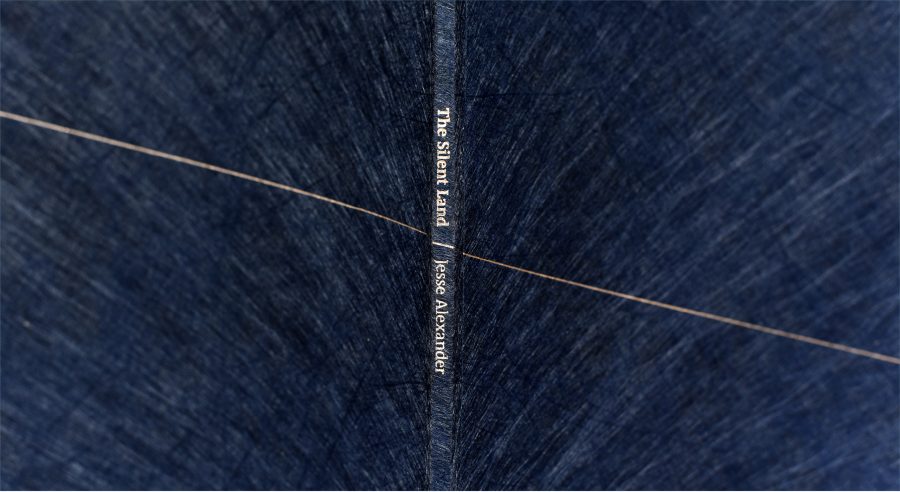The Silent Land: A Case Study
Sustainable Photobook Publishing Network
The Silent Land documents a plantation which grows on the remains of ancient lead works on the Mendip Hills in Somerset where, in 2016, a local man chose to end his life. Against the backdrop of seasonal change and the cycles that are observed over several years, the work explores the elegiac potential of the land and the memorialising act of photography. The book attempts to invite questions around the paradox of outdoor, ‘natural’ spaces — how these provide well documented benefits for health and wellbeing, but are often infused with pathos and melancholy, and are frequently the destination of choice for those seeking to end their lives.

Challenges and Learning
The brief was to produce a high-quality photobook with as minimal negative environmental impact as possible without compromising on quality. In order to achieve this Jesse Alexander (JA) commissioned Victoria Forrest (VF), director of VIKA, to design, produce and publish The Silent Land.
For The Silent Land, due to a combination of supply issues and travel bans coming out of lockdown, it was decided to keep physical production as local as possible. Renewed interest in localised printing after Brexit and C19 has meant that UK-produced books have become a more viable option for smaller print runs with the added bonus of a reduced carbon footprint. A book of a similar specification could well have been printed in Italy at a higher print quality and for a lower price, but it would have come at a different set of costs. Foreign print runs mean longer lead-in times, less quality control for samples and press-passing, as well as, typically, the requirement to print a minimum run of 500 copies. The number of copies is a vital consideration and oscillates between weighing up the available budget against realistic expectations for distribution and sales. The worst thing that can happen to a book is for it to spend its life in storage, as this not only means that the production itself was unnecessary and therefore wasteful, but also quickly incurs costly warehouse fees. If left too long this eventually leads to the tragedy that is books being pulped.
After considering all options Taylor Brothers were chosen as, even though they do not specialise in photobook printing, they are well-established fine art printers and are hyper-local. They are also one of the few UK printers able to claim Certification as Carbon Balanced Printers by the World Land Trust (an international conservation charity endorsed by Sir David Attenborough) as well as FSC Approved. Close proximity to Jesse and Victoria meant that quality control was guaranteed and costly shipping costs, international couriers, press-passing fees, associated emissions and heightened potential for delay at launch were all negated.
Transporting, handling and distributing has mostly been done by Jesse, saving storage and transport. Packaging is made from fully recyclable materials: paper, cardboard and tape. The first 20 copies of the book were accompanied by a unique cyanotype print featuring the poem ‘Remember’ by Christina Rossetti, which was the inspiration for the book’s title. Prints were produced at home on watercolour paper from St. Cuthbert’s Mill in Wells.
The paper stock for the cover, which has fibrous strands infused into the surface, was chosen for its reference to the subject of the book. The manufacturer, G.F. Smith describes these strands as ‘fabric’. Both Jesse and Victoria contacted G.F. Smith to ask about the composition of these fibres and had difficulty getting a consistent answer. At the time of printing, the fibres were described as ‘cellulose’ (an organic substance). But when enquiring again for this case study the fibres were, disappointingly, described as made from polyester.

Materials and Processes
Offset printed and bound in the UK using vegetable inks, on FSC, PEFC approved recycled papers.
- Offset lithographic printing on Heidelberg Speedmaster XL 75
- Paperback cover, full flaps, section sewn
- Cover stock: 290gsm, Twist, G.F. Smith, UK (milled in Italy)
- Internal paper: 135gsm, Heaven 42, G.F. Smith, UK (milled in Germany)
- Size: 180×214 mm, 64 pages
- Edition Size: 300 (signed and numbered)
Cover and internal papers are: FSC and PEFC approved, recyclable, Elemental Chlorine free (ECF), Acid Free, REACH Compliant, Carbon Black Free, Heavy Metal Compliant (94/62), and PAP 21/22.



